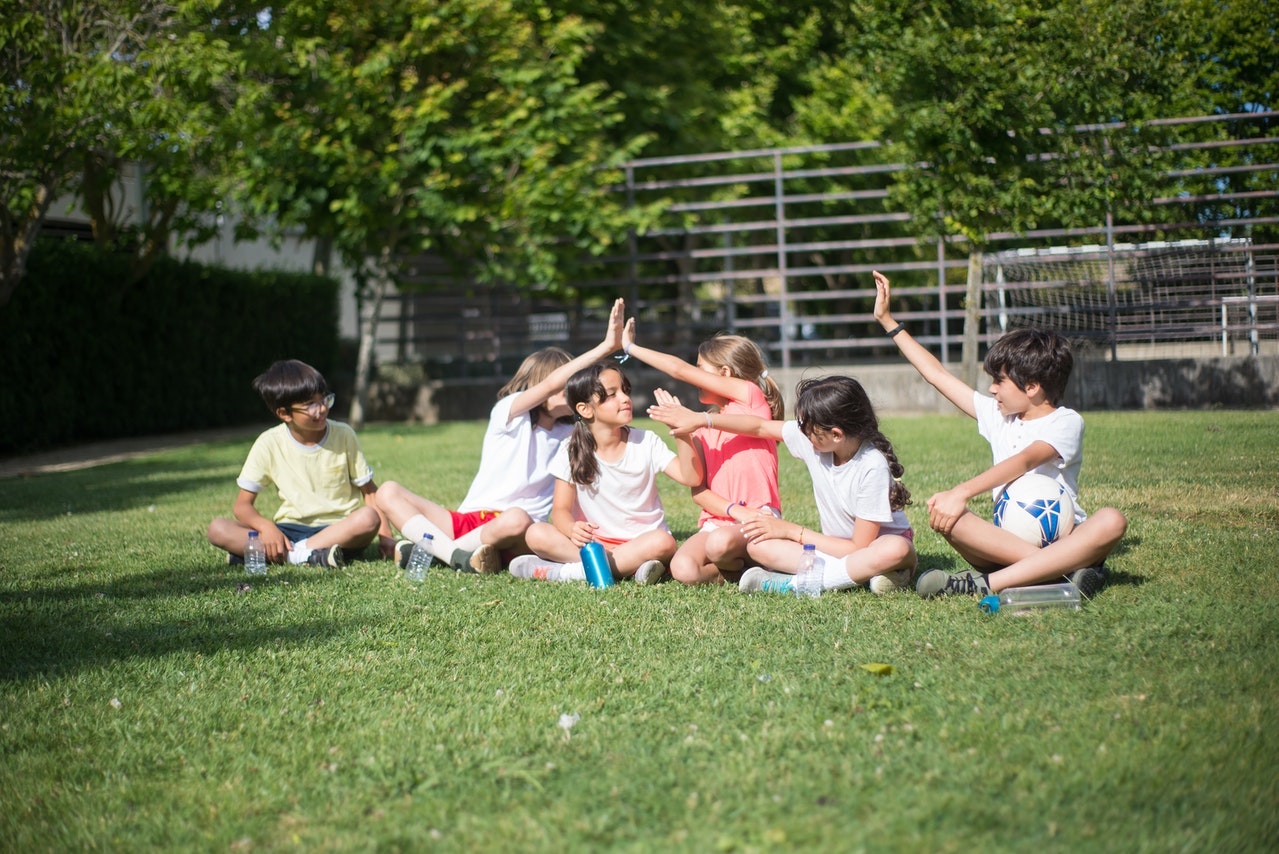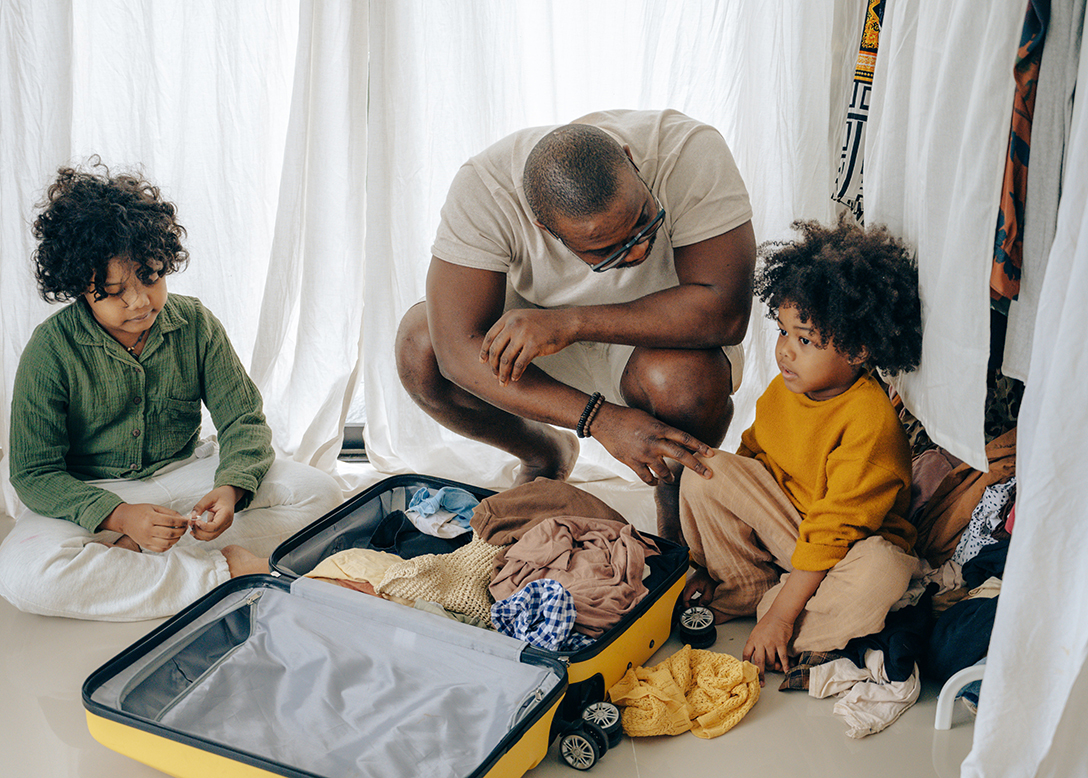by Martha Tyler
Children need a healthy balance of unstructured and structured play. Impromptu and stimulating, no equipment needed games for kids are the perfect answer for creating spontaneous and fun activities that you can easily direct for the children in your care.
Here are 11 fun games that require no equipment and are great for teaching a variety of skills to the children in your care! The bullets provide the basic info about each game, including age level, skills developed, and time needed for each. Instructions for How To Play each game also are included in a step-by-step format.
You just may find that no equipment needed games for kids become the go-to favorites for both the children in your care and you!
Have a happy summer!

Photo courtesy of Kampus Production
Captain’s Coming
- Ages: 4-102 (I honestly haven’t met a person who didn’t enjoy this game on some level)
- Skills Developed: Listening, Memory, Imagination, and Movement
- Time Needed: Explaining it for the first time can take a bit, but once you’re playing, it can be 10 minutes to an hour.
How to Play
- Assign one person to be the “Captain.” This will probably be you for a while until kids are ready to take over! The role of the Captain is to call out the actions and dismiss the players who don’t do the actions quick enough or who break from character. I don’t usually play outs until everyone really understands. With some kids, I never play with outs. You be the judge. You know your kids.
- Here is an explanation of each of the actions:
- Captain’s Coming!: Everyone stands at “attention” (in a salute), and they can’t move from this position until the caller says, “At Ease!” If they laugh or break from the attention, they are dismissed.
- Man Overboard!: One person drops to one knee the other stands behind them, puts a hand on their shoulder. Both scan the ocean for the overboard man
- Crows Nest!: Three players stand backs to each other and lock arms at the elbows to form the crows nest.
- Lighthouse: Two players join arms with a third person in the middle. The middle person spins around.
- Mess Table!: Four players squat in a circle like sitting at table and pretend to eat like they haven’t eaten in days. Tell them to make really loud eating sounds like “YUM YUM YUM YUM YUM!”
- Walk the Plank!: Each player walks in a straight line and says out loud: “ONE TWO THREE SPLASH!”
- Mermaid!: each player individually thrust out right hip, places right hand on that hip, takes left hand and makes a big exaggerated wave and yells out “howdy sailor!” (this one is basically for your own entertainment as it looks hilarious and it gets the participants laughing).
- Iceberg!: Two players grab hands and say “I’ll never let go, Jack”. This one is, again, entertaining for adults.
- Scrub the Deck: Players drop to their hands and knees and pretend to scrub the deck.
- You can also add your own! Something I love about this game is that you can play lots of ways!
Emotion Party
- Ages: 4-40
- Skills Developed: Empathy, Taking Turns, Communication
- Time Needed: 15-20 minutes
How to Play
- Each player thinks of an emotion.
- One person (the host) begins in the center of the room, setting up for a party.
- The host acts in the manner of his/her emotion.
- Another player knocks on the door and is let in by the host.
- The new player must act in the manner of his/her emotion.
- The first person now begins to act in the manner of the second player’s emotion (having guessed what that emotion is).
- A third person knocks and enters with a different emotion.
- Now players one and two must independently identify the new player’s emotion and begin to act in the manner of the emotion.
- Play continues until all of the players have entered the party.
- Players then begin to leave the party, one by one, in the order in which they came and with the emotion he/she demonstrated.
- This continues until the first player, the host, is left alone again, and is back acting in the manner of his/her original emotion.
Notes:
- Try this activity first without any sounds, forcing the kids to think of how to demonstrate the emotion using only their bodies/expressions/actions.
- Consider adding speaking after doing it once without sound.
- Reflect on which way was most challenging, and why?
- Encourage the kids to always be aware of participating in believable activities with other members of the party.
Make a Pizza
- Ages: 2-10
- Skills Developed: Flexibility and Imagination
- Time Needed: 10-20 minutes
How to Play
- Everyone sits with their legs spread straddled out as wide as they can in a circle together.
- Between everyone’s legs is their “slice of pizza.“
- Go through the process of making a pizza. Encourage kids to stretch out and get their whole pizza covered with whatever toppings they are adding. Here are the steps I usually go through:
- Roll out the dough
- Add a sauce (If they want to change it up and make a dessert pizza or anything like that, they can change what kind of sauce they add.)
- Add toppings! (I usually do 3 toppings for each of us and we share each topping as we add it!)
- You can also stretch your imaginations a bit by making pizzas for characters! So what kind of pizza would you make for a dinosaur? What kind of pizza would a giant want? What kind of pizza would you make for a witch? Etc.
Ninja Star, Baby Kitten, Angry Chihuahua
- Ages: 5-105
- Skills Developed: Focus, Communication, Imagination
- Time Needed: 5 minutes
How to Play
- Have the kiddos silently walk around an open space.
- Tell the students that they are going to mime passing different objects from person to person as they walk through the space. To pass an object, they must make perfect eye contact with the person they are passing to.
- Begin by making eye contact with a student and throwing them a ninja star. Feel free to add a sound.
- This ninja star should now get thrown from student to student till it comes back to you.
- Next, throw a baby kitten. Encourage the students to add a sound as they pass it.
- Next, pass an angry chihuahua.
- Reflect on how each of the objects were passed differently.
NOTE: Feel free to take kid suggestions on other objects that can be passed.
I got this one from Beat by Beat Press!
One Word Story
- Ages: 3-13
- Skills Developed: Listening, Communication, Teamwork, Creativity
- Time Needed: 5-15 minutes
How to Play
- Players sit in a circle.
- One person says a single word to begin a story.
- The person to his left says another word, then the next person says another word, continuing around the circle.
- The object is to tell a coherent story, one word at a tim
Two-Headed Monster/Expert
- Ages: 5-15
- Skills Developed: Listening, Communication, Teamwork, Creativity
- Time Needed: 5-15 minutes
How to Play
- Ask two kids to take the stage and link arms.
- They are now a two-headed monster. As a two-headed monster, they talk in one-word turns, keeping the same personality.
- Ask any other kids for a suggestion of an “object” or “place” (if you only have two kids, then you come up with this suggestion).
- The monster must tell a story about that object or place, making it up as they go along.
Notes:
- Encourage the kids to tell a story that has a beginning, middle, and end.
- Encourage the kids to make a strong physical and character choice for their monster.
Shakedown
- Ages: 2-102
- Skills Developed: Movement and is great for when you need to get out some excess energy (I usually encourage this when kids are feeling anxious or jittery or need to get their energy focused on a task.)
- Time Needed: Less than a minute
How to Play
- Put your right hand in the air and shake it while you count VERY LOUDLY down from 10.
- Put your left hand in the air and shake it while you count VERY LOUDLY down from 10.
- Put your right foot out in front of you and shake it while you count VERY LOUDLY down from 10.
- Put your left foot out in front of you and shake it while you count VERY LOUDLY down from 10.
- Put your right hand in the air and shake it while you count VERY LOUDLY down from 9.
- Put your left hand in the air and shake it while you count VERY LOUDLY down from 9.
- Put your right foot out in front of you and shake it while you count VERY LOUDLY down from 9.
- Put your left foot out in front of you and shake it while you count VERY LOUDLY down from 9.
- Continue this pattern until you reach 1. The lower the number gets, the faster you try to move through all your limbs.
- You can pick different start numbers based on time available and how much energy needs an outlet!
Wax Museum or Night at the Museum
- Ages: 5-10
- Skills Developed: Movement, Body Awareness, Imagination
- Time Needed: 20-30 minutes
How to Play
- Explain to the students that they are all statues in a wax museum. You, the caregiver, are the curator.
- Explain what a curator is and explain the concept of a museum if there are any that do not know what one is. You can also say that you’re the night guard.
- Explain that in the beginning, when the curator is in the room (or facing the statue) the statues do not move or speak.
- Once the curator leaves the room (turns their back), the statues come alive and interact with one another.
- When the curator re-enters the room (is facing a statue), the statues all freeze in their current position arid location.
- The curator reacts to these changes and may even begin to correct the obvious problems that have occurred while he/she was out. Some comments: “How could this have happened?” “My statutes must be melting.” “I need to turn up the air conditioning.”
- The statues are now allowed to move while the curator is in the room; but you must not get caught. If at any time the curator sees you move, you are out and must remove yourself from the game. Or you cannot play outs and just say, “Oh! I know I saw that statue move!”
- Take turns letting the kids be the curator or night guard!
Whoosh
- Ages: 3-103
- Skills Developed: Listening, Focus, Silliness
- Time Needed: 5-25 minutes
How to Play
- Everybody stands in a circle.
- Start with one person, who waves both hands to his/her neighbor, saying “Whoosh.”
- The next person passes the Whoosh to his neighbor, and that way the Whoosh is passed around the circle.
- There’s 5 other sounds/movements that can be made (though you can also make up your own):
- “Bonk”: indicated by saying “bonk” and holding up both hands in a stop motion. A “Bonk” changes the direction of the Whoosh.
- “Zap”: instead of passing the Whoosh to your neighbor, it gets zapped to the person you point to with your hands clapped together. The receiver continues with either a Whoosh to his neighbor, or another Zap to another person. A “Bonk” after a Zap returns to the Zapper.
- “Groooooooovelicious”: for this one the whole group bends down and up again in a kinda groovy way, all saying Groooooooovelicious. Afterwards, the person who started the Groovelicious sets the Whoosh in motion again, in any direction.
- “Freakout”: indicated by waving both hands in the air. Everybody starts screaming and moves to the center of the circle. When everybody’s freaked out a new circle is formed, and the starter of the Freakout sets the Whoosh in motion again.
- “Monorail”: If a player says “Monorail” all players turn in a circle in place clapping their hands and marveling at the beauty that is the monorail.
Zip Zap Zop
- Ages: 3-103
- Skills Developed: Focus, Communication, Eye Contact
- Time Needed: 2-20 minutes
How to Play
Level One
- Players stand in a circle.
- One player, Player A, claps his hands, ending in a pointing position toward the direction of another player. Simultaneously Player A will say the nonsense word “Zip!”
- Player B repeats this action, clapping and pointing at another player, Player C, while saying “Zap!”
- Player C repeats this action, pointing at yet again another player while saying the word “Zop!”
- Players do not need to follow any order can clap and point at any other player they choose, but they should follow the patter of “zip, zap, zop.”
Level Two
- After the group has gotten sufficiently good at this, you can have them remove the clapping or the saying of the words “zip, zap & zop.”
- Focus is passed from one person to another by just saying the words or by just clapping, not both.
Level Three
- When they’re really good at that, you can remove any clapping and words all-together. Focus is passed by making direct eye-contact.
Zookeeper
- Ages: 3-8
- Skills Developed: Movement and Imagination
- Time Needed: At least 5 minutes, but can be engaging for a long time
How to Play
- Gather all kids together in an area big enough to move around in
- Bring along a teddy bear or a fellow caregiver (if you’re doing a play date) to give a tour of the zoo. You can also just say you’re going to tend to all your animals as the zookeeper.
- Turn your back towards the kids and say that you want to go to the [insert animal here] exhibit. Give them a little time to ready themselves and then turn towards them and prepared to be WOWed by the animal enclosure. Example: I want to see the penguins! Oh I can’t wait to see some flamingos!
- Ask questions to encourage them to think more deeply about the animals move and carry themselves. Example: How does an elephant walk? How does a lion eat its dinner?
- Repeat until you grow weary of this game. You can switch out an older child for the zookeeper. So you would be the animal with the other kids and the “zookeeper” is now played by a child!


